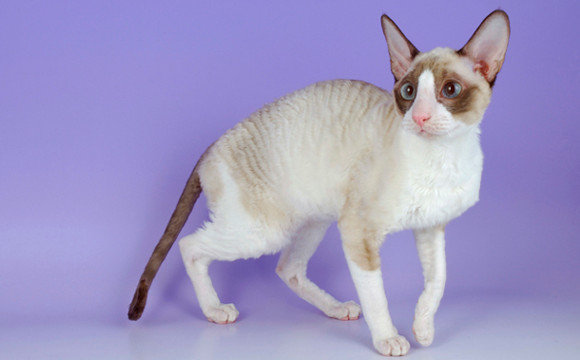Introduction
The Cornish Rex is a unique cat breed known for its curly coat, playful nature, and distinctive appearance. This guide delves into the breed’s history, characteristics, and care needs, offering a thorough overview for current and prospective cat owners.
History of the Cornish Rex
The first Cornish Rex was discovered in 1950 on a farm in Cornwall, England. A tortoiseshell and white domestic cat named Serena gave birth to a litter that included Kallibunker, a curly-coated orange and white male. Kallibunker’s unusual appearance caught the attention of his owner, Nina Ennismore, who consulted a British geneticist. The geneticist confirmed that Kallibunker’s fur was similar to the Rex rabbit’s fur, leading to the name Cornish Rex.
Ennismore bred Kallibunker back to his mother, producing more curly-coated kittens. This new breed was named Cornish Rex because of their resemblance to the Astrex rabbit. In 1957, the breed was introduced to America by Fran Blancheri, where it gained popularity and was later recognized by cat registries.
Physical Characteristics
The Cornish Rex is easily recognizable due to its soft, curly coat, which lacks guard hairs. This breed has a slender, elongated body, large ears, and a wedge-shaped head. Their coat comes in a variety of colors and patterns, adding to their unique appearance.
Key Physical Traits
- Curly Coat: Soft and wavy, without guard hairs.
- Body Structure: Long, slender, and muscular.
- Head Shape: Foreign wedge-shaped with large ears.
- Tail: Slender and tapered.
Personality and Behavior
Cornish Rex cats are known for their playful and affectionate nature. They are highly active, enjoying games and physical activities. These cats are often compared to dogs for their sociable behavior and tendency to follow their owners around the house.
Behavioral Traits
- Playfulness: Enjoys interactive games and toys.
- Affectionate: Loves to cuddle and be close to their owners.
- Inquisitive: Always exploring their surroundings.
- Sociable: Friendly with humans and other pets.
Health and Care
Cornish Rex cats are generally healthy but have some specific care needs due to their unique coat and active nature. Regular grooming is essential to maintain their coat, and they should be bathed occasionally to reduce allergens.
Health Tips
- Regular Vet Visits: Ensure vaccinations and check-ups are up to date.
- Grooming: Brush regularly to keep their coat in good condition.
- Bathing: Occasional baths help reduce allergenic proteins.
- Diet: Provide a balanced diet to support their high energy levels.
Hypoallergenic Qualities
While no cat is truly hypoallergenic, Cornish Rex cats are often better tolerated by people with allergies. Their minimal shedding reduces the spread of allergenic proteins, making them a suitable choice for some allergy sufferers.
Allergy Considerations
- Less Shedding: Reduces the spread of allergens.
- Regular Bathing: Helps minimize allergenic proteins on their fur.
- Consultation: Allergy sufferers should spend time with a Cornish Rex before committing.
Differences from Devon Rex
Though similar, the Cornish Rex and Devon Rex are distinct breeds. The main difference lies in their coat texture and body type. The Devon Rex has a different genetic mutation affecting its fur, leading to a different feel and appearance.
Comparison Points
- Coat Texture: Cornish Rex has a uniform wave, while Devon Rex’s fur is denser and less wavy.
- Body Type: Cornish Rex is more slender, while Devon Rex has a stockier build.
Ideal Living Conditions
Cornish Rex cats thrive in environments where they can interact with their owners and have plenty of space to play. They are indoor cats that enjoy warm, comfortable homes.
Living Environment Tips
- Interactive Toys: Keep them engaged and active.
- Safe Indoor Space: Prevents exposure to outdoor dangers.
- Warmth: They enjoy warm spots due to their thin coat.
Conclusion
The Cornish Rex is a fascinating and loving breed, perfect for those looking for an active and affectionate companion. Their unique appearance and playful nature make them stand out among other cat breeds.
Summary
- Unique Curly Coat: Requires specific grooming.
- Playful and Affectionate: Great for active households.
- Health Care: Regular grooming and vet visits.
- Hypoallergenic Qualities: Suitable for some allergy sufferers.
This comprehensive guide provides all the essential information about the Cornish Rex, helping potential owners understand and care for this remarkable breed. For more details, you can visit Cat’s Place.

